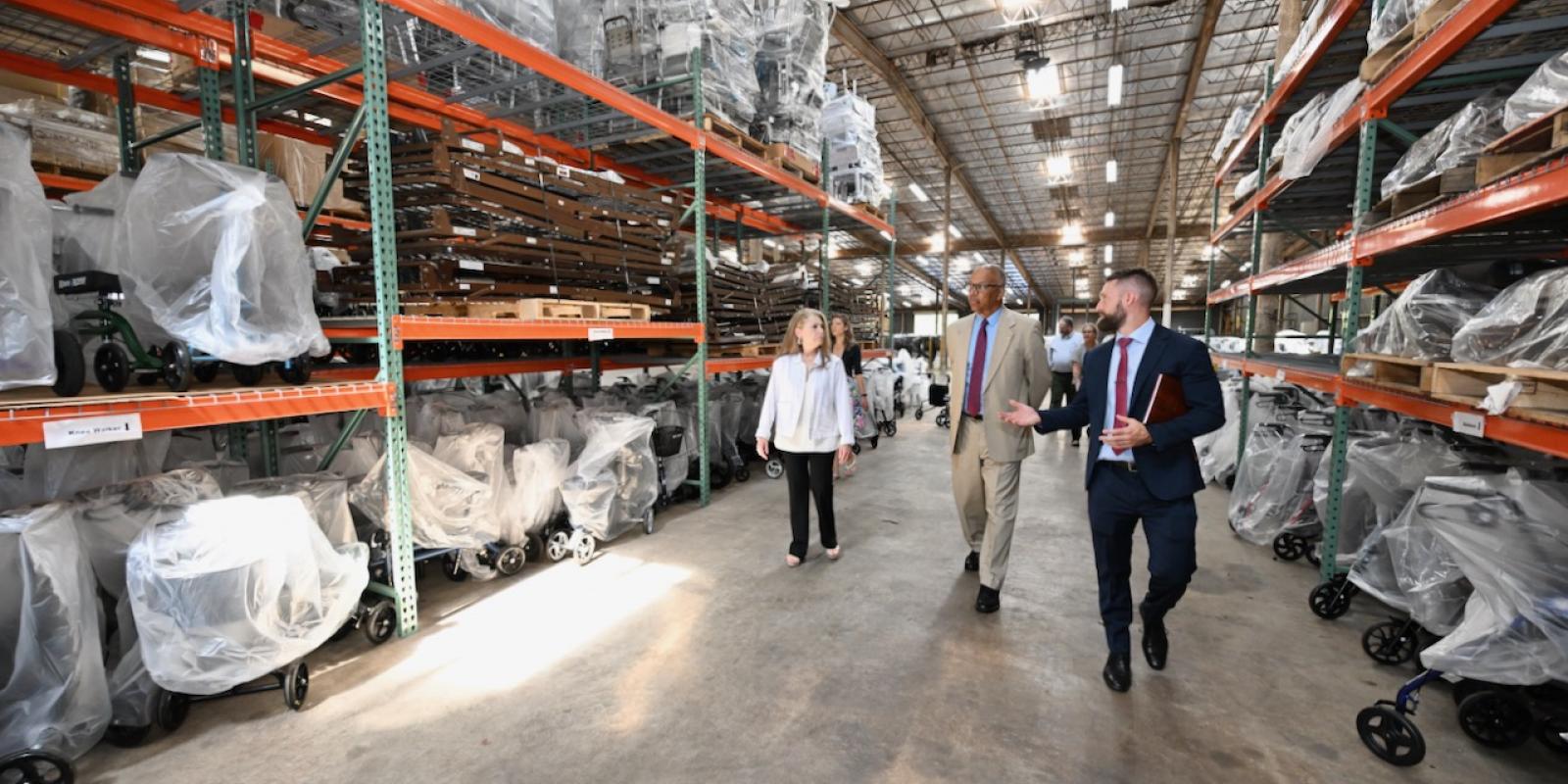What does one do with wheelchairs, walkers and hospital beds that are no longer needed by their original users, but are still in good condition? This is a question many ask when a loved one passes away or no longer needs the equipment. The average wheelchair or walker has a usable life span of more than five years, but often is used for only months, then discarded, resulting in significant waste while the needs of others go unmet.
“When my wife died five years ago, I had to get rid of her wheelchair and two walkers, which she had only used for about six months,” said Dick Olney, of Crofton, Md. “I ended up putting them on the curb for garbage pickup. It’s a shame because I bet someone else could have used them.”
Many organizations across the country do their best to collect and provide durable medical equipment (DME) on a small scale or out of a “loan closet,” to older adults as well as others with disabilities. However, the space needed to store the equipment, as well as the infrastructure necessary to collect, clean, and redistribute DME is often a problem. Sadly, much of this reusable equipment ends up in the landfill, taking up valuable refuse space and leaving many without resources to obtain the equipment they desperately need.
Program Improves Quality of Life for Participants
One program that has overcome the many obstacles to recycling DME, while at the same time serving older adults and others with mobility issues, has been operating in Maryland for the past two years. The Maryland Durable Medical Equipment Re-Use program, implemented by the state’s Department of Aging, has improved the quality of life and independence of thousands of Maryland residents by providing DME free to those in need, regardless of disability or income level.
‘Recently, 1,000 pieces of equipment were shipped to Ukraine to support disabled individuals affected by the war.’
“Before I got the scooter, I was barely able to move around independently in my manual wheelchair,” said Gregory Price of Fort Washington, a recipient of the program whose insurance would not cover the cost of an electric scooter. “Now, I can get to church and other community events, and I am enjoying my newfound freedom.”
Cost is often a serious burden, both to uninsured residents and to insured residents whose insurance will not approve the equipment needed or whose approval is delayed. Due to the success of this statewide program and the amount of equipment gathered, residents of any age or income level are eligible to receive DME.
In addition, the DME Re-Use program has collected enough equipment to support emergency preparedness operations both in state and out of state. Recently, 1,000 pieces of equipment were shipped to Ukraine to support disabled individuals affected by the war. Closer to home, the DME worked with the Maryland Department of Health to supply wheelchairs for handicap access at many pop-up COVID and flu clinics. The DME program also has collaborated with the Maryland Department of Human Services to supply equipment to emergency or other evacuation shelters should the need arise.
“We have more than 1,000 pieces of equipment, including beds, bedside commodes, and walkers stored at our warehouse solely for the purpose of equipping emergency shelters,” said Dr. Ian Edwards, Director of the DME Re-Use program. “We hope we won’t need to but, when the time comes, we are ready and have a plan in place to get the equipment where it is needed.”
While assisting Maryland’s residents is the ultimate goal, the program has seen another benefit: reduced landfill waste, contributing to a lower environmental footprint across the state.
Since the program began, more than 13,353 pieces of DME have been collected, sanitized, repaired, and processed.
“It is with great pleasure that we offer this first of its kind, statewide program that provides free durable medical equipment to all Maryland residents with mobility needs,” said Maryland Department of Aging Secretary Rona E. Kramer. “The benefits of increasing independence, social engagement, safety, and mobility, while reducing environmental waste, are immeasurable.”
Since the program began two years ago at a 51,000-square-foot warehouse located in Cheltenham, Md., more than 13,353 pieces of DME have been collected, sanitized, repaired, and processed. This amounts to 418,000 pounds of waste, or 230,514 cubic feet of space, that is diverted from the landfill. To put this in perspective, this is the same as filling 15 two-story homes from floor to ceiling.
The DME Re-Use program collects equipment via donation from several satellite sites around the state, including collection containers placed at local landfills and waste drop-off sites where residents can put their medical equipment and associated battery donations to be reused, a direct diversion from landfills at the source.
Once brought to the main Re-Use Center, the donated equipment undergoes a thorough sanitation process, ending with a cycle in a machine akin to what one might see in a car wash—known as the “Hub Scrub”—specifically built for sanitizing medical equipment. Once cleaned, equipment is repaired, while non-functional equipment is cannibalized for parts that are saved and later used, further minimizing waste.
Edwards says he’s proud of what they’ve accomplished thus far but adds there’s more work to be done.
“While we have already made a tremendous positive impact, we aim to do more,” said Edwards. “We plan to continue expanding operations, adding additional satellite sites, and getting the word out to everyone about our services.”
To find out more about this innovative program, go to dme.maryland.gov, call 240-230-8000, or email dme.mdoa@maryland.gov.
Barbara Sigler is director of communications at the Maryland Department of Aging in Edgewater.
Photo caption: Maryland Lt. Gov. Boyd Rutherford tours the Maryland DME Re-Use program warehouse with Maryland Department of Aging Secretary Rona E. Kramer and DME Re-Use Director Dr. Ian Edwards.
Photo credit: Courtesy Press Office of the Lt. Gov.













